Abstract
In this paper, we proposed an interval degradation model to improve the reliability of the classical single point degradation model. The interval degradation model is very flexible when model parameters follows different distributions. Twenty-five types of interval Gamma degradation models are considered and discussed under different conditions. The reliabilities of interval Gamma degradation models are obtained. The Monte Carlo method has been studied to compute the reliability and lifetime of interval Gamma degradation model. The numerical examples are conducted to compare the interval degradation model with the classical single point degradation model. Simulation results reveal that the performance of reliability and mean lifetime of interval Gamma degradation model are much better than those of the single Gamma degradation model. Finally, we applied our model to a real data example and demonstrated the effectiveness and feasibility of the interval Gamma degradation model.
1. Introduction
The degradation model, as an important method for reliability evaluation of high-reliability products, has become one of the hot topics in reliability theory and engineering [1,2,3,4]. In much of the literature [5,6,7,8,9,10,11,12,13,14], degradation paths have been modeled by the general degradation process and the Stochastic process (SP) models, such as the Wiener process, Gamma process, inverse Gaussian process, and exponential dispersion process. For the Wiener process, it is known that the degradation path is not a strictly increasing function. The degradation is monotonic when it is in the form of wear and cumulative damage. The Gamma process and the inverse Gaussian (IG) process have a monotonic degradation path and received wide applications when the monotonicity is necessary [1,9]. The scarce application of IG processes in degradation modeling might be attributed to its unclear physical meaning to reliability engineers, in contrast to the well-known Wiener and Gamma processes [9]. Degradation models based on the Gamma process have been identified as the main way to model degradation processes given the characteristic that its increments are independent and non-negative having a gamma distribution with an identical scale parameter [10]. Gamma processes were satisfactorily fitted to data on creep of concrete, fatigue crack growth, corroded steel gates, thinning due to corrosion, and chloride ingress into concrete [11]. The Gamma process is the limit of a compound Poisson process [11,15]. This property is quite meaningful in degradation modeling, as many engineers believe that many degradation phenomena are caused by external shocks. Moreover, the shock magnitude is random and small, and the shock arrival process is described by a compound Poisson process. Ref. [9] also gives the physical interpretation of the IG process by showing that it is a limiting compound Poisson process under some conditions. The physical interpretation of Gamma process is more intuitive and natural than that of the IG process. Furthermore, many previous studies [16,17] revealed that the Gamma process is more suitable for describing the degradation path.
Thus, in this paper, we assumed the degradation path is the Gamma process. Fixed failure thresholds were used for reliability assessment for the reason that product failure is generally defined as degradation of the performance below or above a fixed threshold value. This definition of fixed failure threshold degradation is called single point degradation. This definition is simple and useful for study but is not reasonable to describe the failure of the product completely.
In practice, it is difficult to express the failure threshold of the equipment with a fixed value because of the differences among the test samples and the combined effect of the uncertainty of external stress during use. For example, the shape variable of the coil spring, the drift of the gyroscope, or the wear degree of mechanical parts [18,19].
Peng et al. [20] first proposed the concept of uncertain/random failure threshold in the process of degradation modeling. The results showed that the uncertain/random failure threshold was more credible for equipment reliability evaluation. However, the specific distribution type of failure threshold and the analytical expression of remaining life were not provided in this study. Usynin et al. [21] discussed the influence of reliability estimation for random failure threshold in cumulative damage model based on linear Wiener process, but still failed to provide the specific distribution type of failure threshold and the analytical expression of remaining life. Huang et al. [22] proposed the use of normal distribution to describe the random failure threshold and derived the corresponding integral expression of equipment reliability. Ma Qiang [23] assumed that the random failure threshold was a normal distribution, and carried out reliability assessment and analysis for the linear degradation model, but the conclusion was only suitable for the linear degradation model. Wang Zezhou et al. [24] assumed that the random failure threshold was a non-negative normal distribution, and predicted and evaluated the residual life of the Wiener degradation process. Paroissin and Salami [25] analyzed the Gamma degradation process when the threshold is exponentially or Gamma distributed.
In summary, the threshold value is regarded as a random variable in the literature above, which effectively solves the disadvantage of a fixed threshold value. There are two deficiencies. Firstly, it is simply assumed that the threshold is a random variable, and there is no restriction to the range of its value. It is unreasonable for the threshold to be very small or large. For example, Kuitche (2010) [26] assumed that if the output power degradation rate of photovoltaic modules increases to a threshold level, the photovoltaic modules fail. If the threshold value is regarded as a random variable and follows exponential or Gamma distribution at [25], it is obviously unreasonable because the output power degradation rate at . The threshold value follows exponential or Gamma distribution at interval is more reasonable. Thus, it is more realistic to describe the threshold by random variables within a certain interval. Secondly, the current literature usually assumes that the thresholds are normally distributed, which may not be consistent with practical situations.
Guan Qiang [27] first proposed the interval degradation model and assumed that the threshold is a random variable within a certain interval. The interval degradation process is shown in Figure 1, which solves the interval modeling problem of linear degradation. Guan Qiang [28] further carried out interval type modeling and analysis for the exponential degradation model. This paper assumes that the threshold is normal distribution, uniform distribution, Gamma distribution, exponential distribution, and Weibull distribution within a certain interval, and discusses the corresponding reliability assessment of different random effects of the Gamma process degradation model. The estimation of reliability function for interval type and single point type degradation models were compared and analyzed.
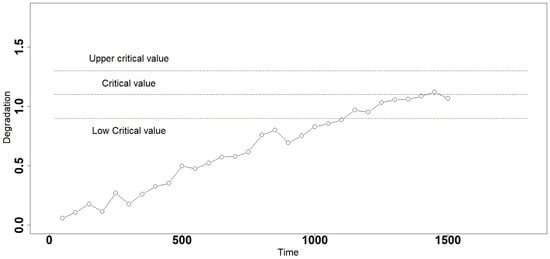
Figure 1.
Interval degradation.
The rest of this article is organized as follows. In Section 2, we introduced the interval Gamma degradation models and the assumptions used in the study. In Section 3, the reliability of different interval Gamma degradation models is demonstrated in theorems. In Section 4, we proposed Monte Carlo method and computed the reliability for different interval Gamma degradation models. In Section 5, simulations are conducted to show the effectiveness of the interval Gamma degradation models. An example of real data is analyzed in Section 6. The conclusion and discussion are shown in Section 7.
2. Interval Degradation Model
In many engineering applications, the failure time T for an item is defined as the time at which the degradation path first reaches a pre-determined fixed threshold . The lifetime T is defined as follows
where is a an increasing function. It is unrealistic to expect the threshold value D to be a fixed constant . D is considered as a random variable in the literatures [20,21,24,25]. For example, Ref. [25] assumed D is exponentially or Gamma distributed at . However, the random D has the boundary . The boundary is generally assumed to be known and given according to expert judgments. For example, a tire failure is considered when tire wear reaches a certain value D. Obviously, the boundary of D is , where L is the length of the tire. Thus, the threshold value D is assumed to be a random variable and in a certain interval is more scientific.
2.1. General Interval Degradation Model
The cumulative distribution function (CDF) of lifetime T is
where D is a random threshold value at interval , is the parameters of the degradation model. values are determined by expert judgements and engineering experiences. In general, let . represent the range of uncertain of threshold value.
2.2. Gamma Degradation Model
The degradation path is assumed to be Gamma process, . The Gamma process has the following properties:
- with probability one;
- has independent increments; that is, and are independent, ;
- .
where is a Gamma distribution with shape parameter and scale parameter , and the corresponding probability density function (PDF) is
where , is a known parameter for describing the common performance of product. is a random parameter for describing the different performance of product.
The traditional degradation models usually assume that D is fixed and the are non-random parameters in (1). In this situation, the CDF of lifetime T is
where (4) is the same as Theorem 2.1 of [25].
When is a random parameter, we called (3) a random effect Gamma degradation model. is usually assumed to be a Gamma distribution, Gamma , and the corresponding PDF of is
Hence the PDF of is
From (5), it is easy to prove that the random variable follows an F distribution with and degrees of freedom.
When D is fixed, is an unknown parameter and is a random parameter with Gamma distribution. The CDF of lifetime T is
where is the CDF of the F distribution with and degrees of freedom.
2.3. Random Effect Gamma Degradation Model Testing
The degradation data are
Null hypothesis : is an unknown parameter.
Alternative hypothesis : is a random variable (such as is a Gamma distribution).
When holds, according to (3), the likelihood function is
The maximum likelihood estimation (MLE) of and are denoted by and , and the estimation of and is similar to [29].
When holds, according to (5), the likelihood function is
The MLE of and are denoted by and .
The likelihood ratio test . When , . Thus, when significance level and is given, the rejection region is
2.4. Interval Gamma Degradation Model
The CDF of lifetime T is
where, is a Gamma process, D is a random threshold value at interval , and is a random parameter. When is assumed to be an X distribution and D is assumed to be a Y distribution in (7), we called that an X-Y interval Gamma degradation model and in short an X-Y interval model. When is assumed to be an X distribution and D is a fixed value in (7), we called it an X-random effect single point Gamma degradation model and in short an X-Random effect model. D is a random threshold value in the interval , thus, Y distribution usually truncate the distribution in interval also. In the following, we compared the interval and single point Gamma degradation models under different situations.
3. Reliability of Interval Gamma Degradation Model
Theorem 1.
β is assumed to be a Gamma distribution in (7).
- The threshold value D is a fixed value . According to (6), the reliability of the Gamma-Random effect single point Gamma degradation model is
- When the threshold value D is a uniform distribution , the reliability of the Gamma-Uniform interval model is
- When the threshold value D is assumed to be a truncated normal distribution , the reliability of the Gamma-Normal interval model iswhere .
- When the threshold value D is a truncated exponential distribution , the reliability of the Gamma-Exponential interval model iswhere .
- When the threshold value D is a truncated Weibull distribution , the reliability of the Gamma-Weibull interval model iswhere .
- When the threshold value D is a truncated Gamma distribution , the reliability of the Gamma-Gamma interval model iswhere , is the CDF of .
Proof.
See Appendix A. □
Remark 1.
Theorem 2.
β is assumed to be a uniform distribution U in (7).
- When the threshold value D is a fixed value , the reliability of the Uniform-Random effect single point Gamma degradation model iswhere is the CDF of .
- When the threshold value D is an uniform distribution , the reliability of the Uniform-Uniform interval model is
- When the threshold value D is a truncated normal distribution , the reliability of the Uniform-Normal interval model is
- When the threshold value D is a truncated exponential distribution , the reliability of the Uniform-Exponential interval model is
- When the threshold value D is a truncated Weibull distribution , the reliability of the Uniform-Weibull interval model is
- When the threshold value D is a truncated Gamma distribution , the reliability of the Uniform-Gamma interval model is
Proof.
See Appendix B. □
Theorem 3.
β is assumed to be a exponential distribution in (7).
- When the threshold value D is a fixed value , the reliability of the Exponential-Random effect single point Gamma degradation model iswhere is CDF of F distribution with and 2 degrees of freedom.
- When threshold value D is an uniform distribution . The reliability of the Exponential-Uniform interval model is
- When the threshold value D is a truncated normal distribution , the reliability of the Exponential-Normal interval model is
- When the threshold value D is a truncated exponential distribution , the reliability of the Exponential-Exponential interval model is
- When the threshold value D is a truncated Weibull distribution , the reliability of the Exponential-Weibull interval model is
- When the threshold value D is a truncated Gamma distribution , the reliability of the Exponential-Gamma interval model is
Proof.
See Appendix C. □
Theorem 4.
β is assumed to be a Weibull distribution in (7).
- When the threshold value D is a fixed value , the reliability of the Weibull-Random effect single point Gamma degradation model iswhere is the CDF of .
- When the threshold value D is an uniform distribution , the reliability of the Weibull-Uniform interval model is
- When the threshold value D is a truncated normal distribution , the reliability of the Weibull-Normal interval model is
- When the threshold value D is a truncated exponential distribution , the reliability of the Weibull-Exponential interval model is
- When the threshold value D is a truncated Weibull distribution , the reliability of the Weibull-Weibull interval model is
- When threshold value D is a truncated Gamma distribution , the reliability of the Weibull-Gamma interval model is
Proof.
See Appendix B. □
Theorem 5.
β is assumed to be a truncated normal distribution in (7).
- When the threshold value D is a fixed value , the reliability of the Normal-Random effect single point Gamma degradation model iswhere ,
- When the threshold value D is an uniform distribution , the reliability of the Normal-Uniform interval model is
- When the threshold value D is a truncated normal distribution , the reliability of the Normal-Normal interval model is
- When the threshold value D is a truncated exponential distribution , the reliability of the Normal-Exponential interval model is
- When the threshold value D is a truncated Weibull distribution , the reliability of the Normal-Weibull interval model is
- When the threshold value D is a truncated Gamma distribution , the reliability of the Normal-Gamma interval model is
Proof.
See Appendix B. □
4. Estimate Reliability for Interval Degradation Model
From Theorems 1–5, most of the reliabilities of the product have no analytical form. When all parameters degradation model are estimated, the reliability of the product cannot be obtained.
We adopt the Monte Carlo method to compute these integrations. From Theorems 1–5, most of the reliabilities have following form
where are known density functions in and , respectively, and is a known function. Thus, we can use following steps of compute the reliability.
- Draw M random samples from density function .
- Draw N random samples from density function .
- For fixed t,
For the general interval degradation model (2), its CDF of lifetime and reliability can be estimated by following steps of the Monte Carlo method.
- Draw a random sample from density function , and obtain the degradation path .
- Draw a random sample from density function , and compute the lifetime .
- Repeat step 1 and 2 by N times, and obtain the lifetime .
- For fixed t, calculate the number of , and denote the result by , then the CDF of lifetime and reliability can be estimated by
5. Simulation Comparison Results
For simplicity, we used the following terminologies in the simulation results: (i) the No-random effect Gamma process degradation model for , , and D is fixed, (ii) the Random effect Gamma process degradation model for and D is fixed and follows corresponding distributions, (iii) the X-Y interval Gamma process degradation model (Random effect interval Gamma process degradation model) for is fixed, and D follow X and Y distributions, respectively. For comparing those degradation models in the simulation: (i) let , and in (3) for the No-random effect Gamma process degradation model; (ii) let , , , and follows the Gamma distribution , Uniform distribution , Weibull distribution , Exponential distribution , and Normal distribution with the same mean of 30 for different random effect Gamma process degradation model respectively. (iii) let , , follows different distributions with the same mean 30 and D follows different distributions at interval with the same mean of 60 for different X-Y interval Gamma process degradation model, respectively. Interval represents the range of uncertain of threshold value 60. values are determined by expert judgments and engineering experiences. In general, let . Two interval cases and are considered in this simulation. The reliability of the X-Y interval and single point Gamma process degradation model (No-random effect and Random effect Gamma process degradation models) are calculated from Theorems 1–5 and Section 4. According to these terminologies, the model in Section 5.1 of [25] is the Gamma-Gamma interval Gamma process degradation model, and the interval is . The results are shown in Figure 2, Figure 3, Figure 4, Figure 5, Figure 6, Figure 7, Figure 8, Figure 9, Figure 10, Figure 11, Figure 12, Figure 13, Figure 14, Figure 15, Figure 16, Figure 17, Figure 18, Figure 19, Figure 20, Figure 21, Figure 22, Figure 23, Figure 24, Figure 25 and Figure 26. The mean lifetime, 10 percent lifetime, and 90 percent lifetime for the different models are listed in Table 1.
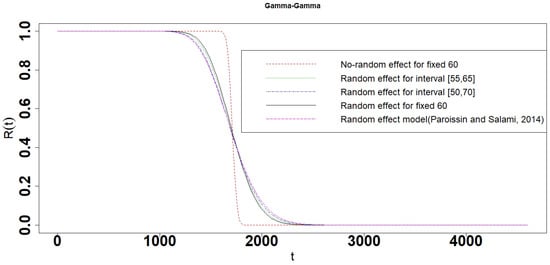
Figure 2.
Reliability of the Gamma-Gamma interval degradation model.
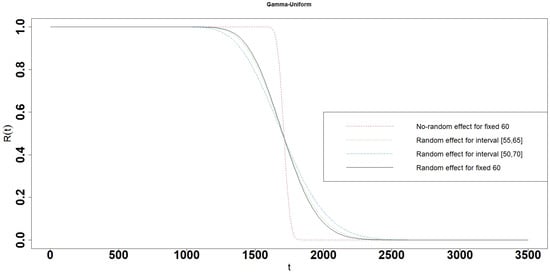
Figure 3.
Reliability of Gamma-Uniform interval degradation model.
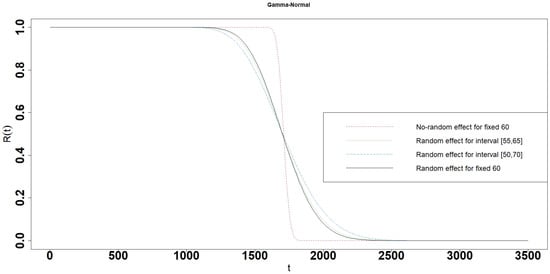
Figure 4.
Reliability of the Gamma-Normal interval degradation model.

Figure 5.
Reliability of the Gamma-Exponential interval degradation model.
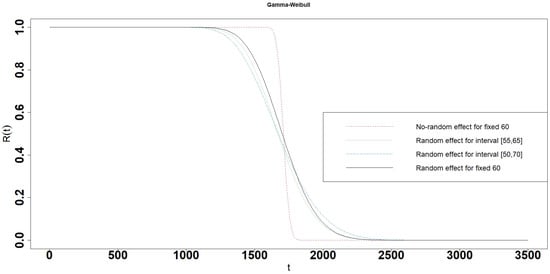
Figure 6.
Reliability of the Gamma-Weibull interval degradation model.
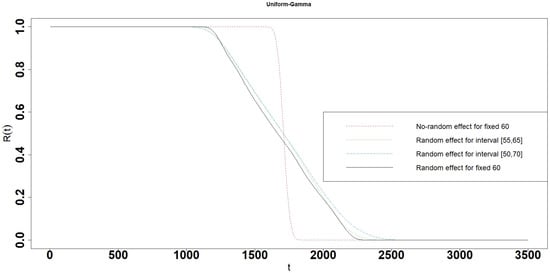
Figure 7.
Reliability of the Uniform-Gamma interval degradation model.
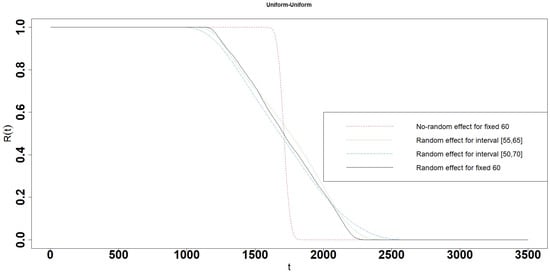
Figure 8.
Reliability of the Uniform-Uniform interval degradation model.

Figure 9.
Reliability of Uniform-Normal interval degradation model.
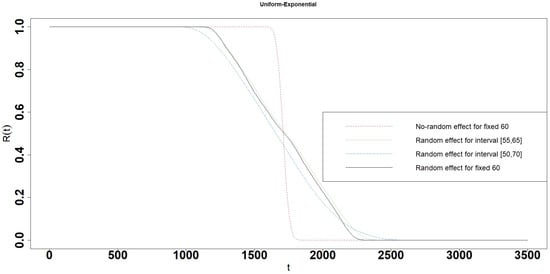
Figure 10.
Reliability of the the Uniform-Exponential interval degradation model.
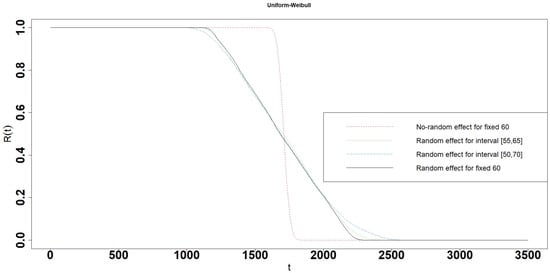
Figure 11.
Reliability of the Uniform-Weibull interval degradation model.
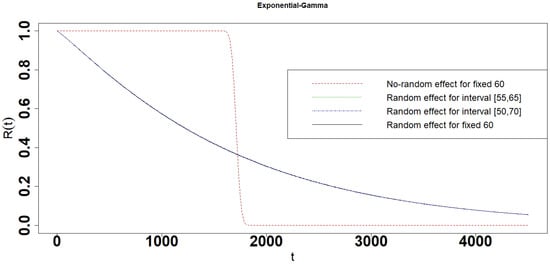
Figure 12.
Reliability of the Exponential-Gamma interval degradation model.
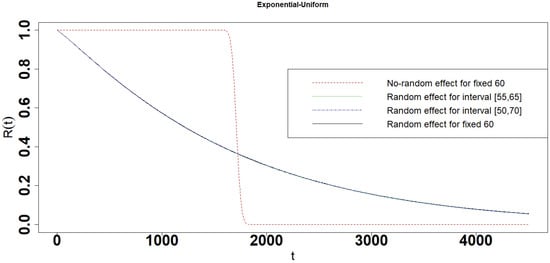
Figure 13.
Reliability of the Exponential-Uniform interval degradation model.
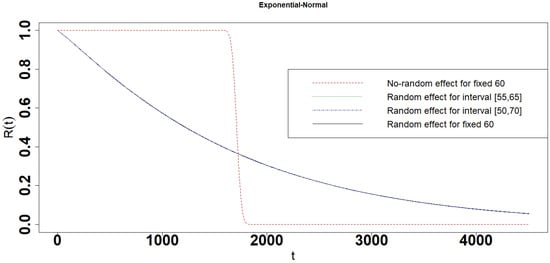
Figure 14.
Reliability of the Exponential-Normal interval degradation model.
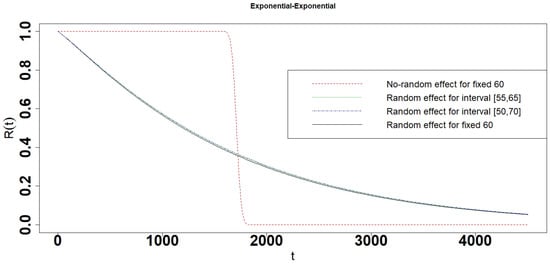
Figure 15.
Reliability of the Exponential-Exponential interval degradation model.
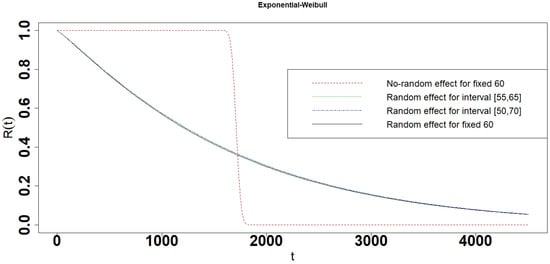
Figure 16.
Reliability of the Exponential-Weibull interval degradation model.
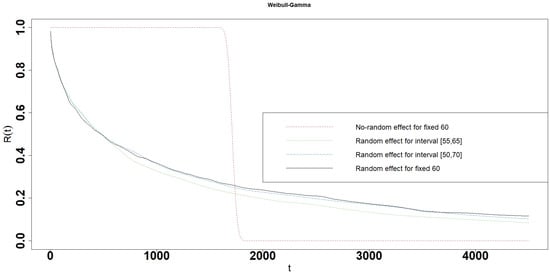
Figure 17.
Reliability of the Weibull-Gamma interval degradation model.
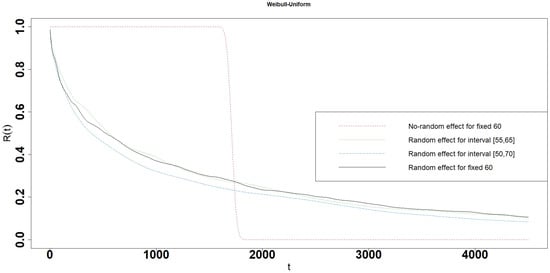
Figure 18.
Reliability of the Weibull-Uniform interval degradation model.

Figure 19.
Reliability of the Weibull-Normal interval degradation model.
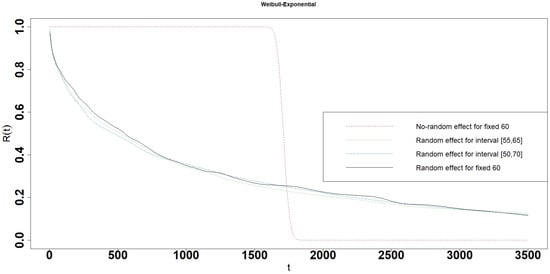
Figure 20.
Reliability of the Weibull-Exponential interval degradation model.
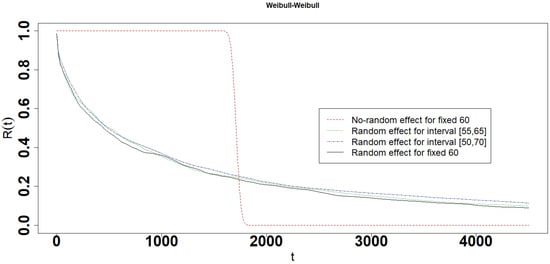
Figure 21.
Reliability of the Weibull-Weibull interval degradation model.
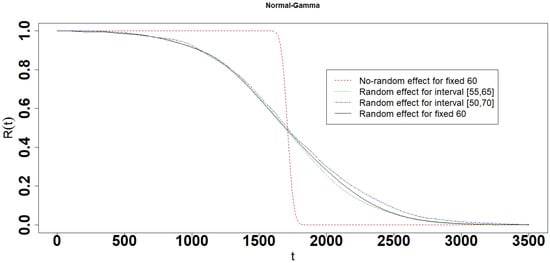
Figure 22.
Reliability of the Normal-Gamma interval degradation model.

Figure 23.
Reliability of the Normal-Uniform interval degradation model.
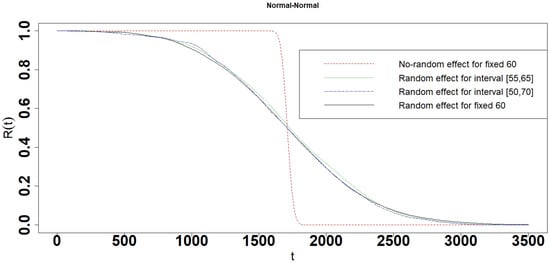
Figure 24.
Reliability of the Normal-Normal interval degradation model.
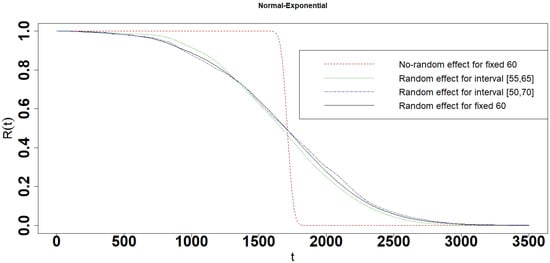
Figure 25.
Reliability of the Normal-Uniform interval degradation model.
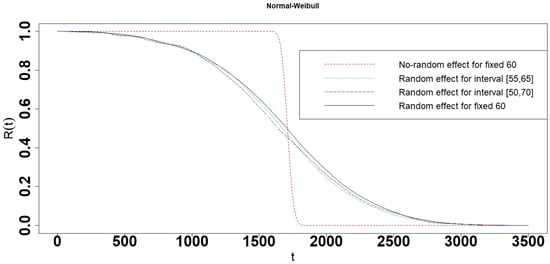
Figure 26.
Reliability of the Normal-Normal interval degradation model.

Table 1.
The life time for the different models.
Some points are quite clear from Figure 2, Figure 3, Figure 4, Figure 5, Figure 6, Figure 7, Figure 8, Figure 9, Figure 10, Figure 11, Figure 12, Figure 13, Figure 14, Figure 15, Figure 16, Figure 17, Figure 18, Figure 19, Figure 20, Figure 21, Figure 22, Figure 23, Figure 24, Figure 25 and Figure 26, and Table 1.
- The reliability, 10 percent lifetime, and 90 percent lifetime of the No-random effect model are significantly different from the random effect model and interval model. It suggests that the test of original data being random or non-random is critical before choosing the model to use.
- When the parameter follows exponential distribution, the reliabilities, 10 percent and 90 percent lifetime are almost the same in Random effect model and interval degradation models (Table 1 and Figure 12, Figure 13, Figure 14, Figure 15 and Figure 16). In other words, the Random effect single degradation model and Random effect interval degradation model are the same in such cases.
- The reliabilities, 10 percent and 90 percent lifetime of the random effect models except for the Exponential random effect model are a little different from the interval model. The differences of reliabilities, 10 percent and 90 percent lifetime between the random effect and interval models become larger, when the length of interval is increasing (Table 1 and Figure 3, Figure 4, Figure 5, Figure 6, Figure 7, Figure 8, Figure 9, Figure 10, Figure 11, Figure 12, Figure 13, Figure 14, Figure 15, Figure 16, Figure 17, Figure 18, Figure 19, Figure 20, Figure 21, Figure 22, Figure 23, Figure 24, Figure 25 and Figure 26).
- The mean lifetimes of the Normal random effect model, Normal-Y interval model, Gamma random effect model, Gamma-Y interval model, Uniform random effect model, and Uniform-Y interval model are almost the same as the No-random effect model. However, the mean lifetimes of the Exponential random effect model, Exponential-Y interval model, Weibull random effect model, and Weibull-Y interval model are quite different from the No-random effect model (Table 1). In other words, it needs to be more prudent to use the Exponential random effect model, Exponential-Y interval model, Weibull random effect model, and Weibull-Y interval model until having robust data to show that follows exponential distribution or Weibull distribution is compelling.
6. Real Data Analysis
In this section, we used a real data example from the photovoltaic module problem described by Kuitche (2010) [26] to test the model we proposed. When the output power degradation rate of photovoltaic modules increases to a certain level, the photovoltaic modules fail. Therefore, the output power degradation rate of photovoltaic modules can be treated as the degradation characteristic , and obviously, . The real data of output power degradation rate of photovoltaic modules is shown in Table 2. The degradation characteristic (Liu et al. (2020) [30]) is assumed to follow the Gamma process and is presented by

Table 2.
The output power degradation rate of photovoltaic modules.
Here, we also assume in (3). Liu et al. (2020) assumed in Equation (3) follows the Gamma distribution . We use the likelihood ratio test for the random effect , the result are listed in Table 3.

Table 3.
The likelihood ratio test for the Gamma process.
We reject that the null hypothesis is significant because the p-value = 0.001 < 0.05. Thus, following Gamma distribution holds. Liu et al. (2020) [30] is assumed to fail when the output power degradation rate increases by from its initial value. For the interval degradation model, the photovoltaic modules are assumed to fail when the output power degradation rate D increases at an interval from its initial value. Two cases and of the interval are considered in this real data analysis. D follows different distributions with the same mean . Thus, we calculate the reliabilities and mean lifetimes for different models by Theorem 1 and Section 4. We also calculate the reliability and mean lifetime for the Gamma process degradation model [25] in interval . The results are shown in Figure 27, Figure 28, Figure 29, Figure 30 and Figure 31 and Table 4.

Figure 27.
Reliability of the photovoltaic module for the Gamma-Gamma interval degradation model.
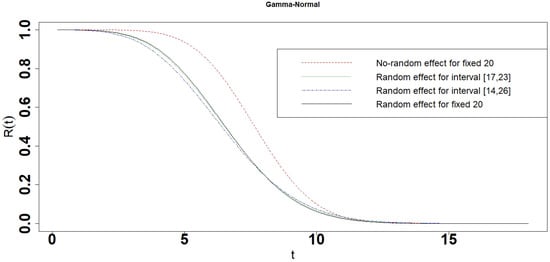
Figure 28.
Reliability of the photovoltaic module for the Gamma-Normal interval degradation model.
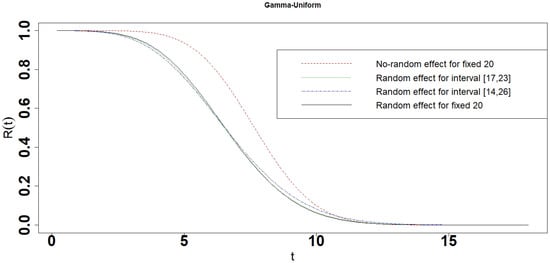
Figure 29.
Reliability of the photovoltaic module for the Gamma-Uniform interval degradation model.
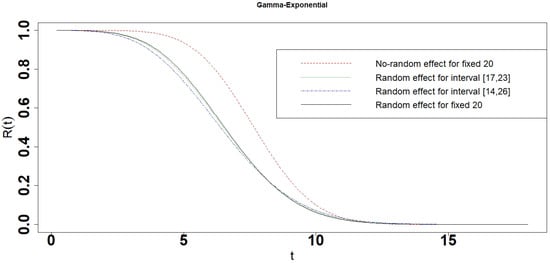
Figure 30.
Reliability of the photovoltaic module for the Gamma-Exponential interval degradation model.
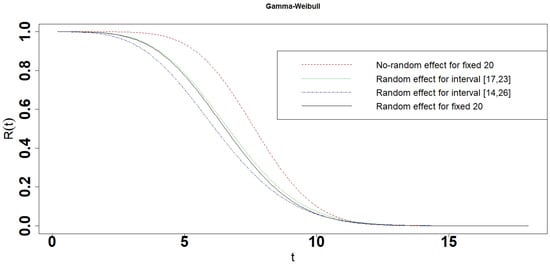
Figure 31.
Reliability of the photovoltaic module for the Gamma-Weibull interval degradation model.

Table 4.
The lifetime of photovoltaic module for the different models.
Figure 27 and Table 4 show that the range of reliabilities and the length of the 10 percent lifetime and the 90 percent lifetime for Gamma-Gamma interval model increased with the length of intervals , and [25]. Figure 27, Figure 28, Figure 29, Figure 30 and Figure 31 show that the reliabilities of No-random effect models are always larger than those of interval degradation models. No-random effect model is easily affected by a photovoltaic module S73L47 because the reliability of photovoltaic module S73L47 is larger than that of other modules. The reliability of the interval degradation model is more realistic to reflect the photovoltaic modules, which take into account all the photovoltaic modules at the same time. The performances of interval degradation models are similar to random effect models. Table 4 shows that the mean lifetime of the No-random effect model is years which is close to years and years, which were estimated by Liu et al. (2020) [30]. The mean lifetimes of interval degradation models are close to years and are consistent with the photovoltaic modules S70L45, S72L46, and S71L48. The 10 percent lifetimes of interval degradation models are smaller than that of random effect degradation models, especially No-random effect degradation models. It indicates that No-random and random effect degradation models would overestimate the 10 percent lifetime of photovoltaic modules. The 90 percent lifetime of interval degradation models is between that of the random effect degradation model and the No-random effect degradation model.
7. Conclusions
In this study, we proposed an interval degradation model and demonstrated that it is more flexible and has better performance than the single degradation model. When the threshold values are uncertain, using the single degradation model will lead to considerable deviation.
We conducted five theorems for comparing the reliabilities of interval and single Gamma degradation models. The Monte Carlo method has been used to compute the reliability of interval Gamma degradation model. Simulation results showed that the reliability and mean lifetime of the interval Gamma degradation model are much better than those of the single Gamma degradation model. The analysis of the example from real data also showed the effectiveness and feasibility of the interval Gamma degradation model.
In summary, our study contributes in two aspects. Firstly, we proposed the interval degradation model. It solves the problem of how to define the failure of the degradation model when the threshold values are uncertain. Secondly, the simulation results revealed that the proposed interval degradation models have more accurate estimations when compared with the single Gamma degradation model (No-random effect model and random effect model).
In the future, the interval failure method will be modelled for the Stress-Strength reliability model [31] and the competing failure degradation process model [32,33,34] when the threshold values are uncertain. Moreover, how to model the multi-state system model [35] and finite degradation model [36] and the remaining useful lifetime estimate model [37] with the interval failure method is also worth to explore for further study.
Author Contributions
Conceptualization, Q.G.; Formal analysis, G.L.; Supervision, Y.T. (Yincai Tang); Writing—review & editing, Y.T. (Yunhuei Tzeng). All authors have read and agreed to the published version of the manuscript.
Funding
The research is supported by the Natural Science Foundation of China (10571057), Natural Science Foundation of Fujian Province, China (2019J01821), Young Teacher Education Research Project of Fujian Province (JAS19346), Fujian Key Lab of Agriculture IOT Application, Digital Fujian research institute for industrial energy big data, and IOT Application Engineering Research Center of Fujian Province Colleges and Universities).
Institutional Review Board Statement
Not applicable.
Informed Consent Statement
Not applicable.
Data Availability Statement
All data generated or used during the study are available in a repository (Provide full citations). All data included in this study are available upon request by contact with the corresponding author.
Acknowledgments
The authors thank the anonymous referee for helping us to improve the article.
Conflicts of Interest
The authors declare no conflict of interest.
Appendix A
We first prove that the reliability of the Gamma-Uniform interval model ( is assumed to be a Gamma distribution and threshold value D is an uniform distribution ).
Proof of Theorem 1.
□
Similarly, we can prove the reliability of the Gamma-Gamma, Gamma-Normal, Gamma-Exponential and Gamma-Weibull interval models.
Appendix B
Proof of Theorems 2, 4 and 5.
We first prove the reliability of the Uniform-Normal interval model. For fixed D and ,
where is the CDF of .
For fixed D, is assumed to be a uniform distribution U,
When is assumed to be an uniform distribution U, and D is a truncated normal distribution ,
Thus,
□
Similarly, we can prove the reliability of the Uniform-Gamma, Uniform-Uniform, Uniform-Exponential, Uniform-Weibull interval models in Theorems 2, 4, and 5.
Appendix C
Proof of Theorem 3.
We first prove that the reliability of Exponential-Uniform interval model. is assumed to be an exponential distribution in (7), and the PDF of is
Thus, the random variable has a F distribution with and 2 degrees of freedom. When threshold value D is a fixed value, the CDF of is
When D is a uniform distribution at , the reliability of the Exponential-Uniform interval model is
□
Similarly, we can prove the reliability of the Uniform-Gamma, Uniform-Uniform, Uniform-Exponential, and Uniform-Weibull interval models in Theorem 3.
References
- Ye, Z.S.; Xie, M. Stochastic modelling and analysis of degradation for highly reliable products. Appl. Stoch. Model. Bus. Ind. 2015, 31, 16–32. [Google Scholar] [CrossRef]
- Zhao, J.B.; Si, S.B.; Cai, Z.Q. A multi-objective reliability optimization for reconfigurable systems considering components degradation. Reliab. Eng. Syst. Saf. 2019, 183, 104–115. [Google Scholar] [CrossRef]
- Zhang, F.D.; Ng, H.K.T.; Shi, Y.M. Mis-specification analysis of Wiener degradation models by using f-divergence with outliers. Reliab. Eng. Syst. Saf. 2019, 195, 106751. [Google Scholar] [CrossRef]
- Zhang, Z.X.; Si, X.S.; Hu, C.H.; Lei, Y. Degradation data analysis and remaining useful life estimation: A review on Wiener-process-based methods. Eur. J. Oper. Res. 2018, 271, 775–796. [Google Scholar] [CrossRef]
- Si, X.S.; Wang, W.B.; Hu, C.H.; Zhou, D.H. Remaining useful life estimation—A review on the statistical data driven approaches. Eur. Oper. Res. 2011, 213, 1–14. [Google Scholar] [CrossRef]
- Peng, C.; Tseng, S. Mis-specification analysis of linear degradation models. IEEE Trans. Reliab. 2009, 58, 444–455. [Google Scholar] [CrossRef]
- Tang, S.J.; Guo, X.S.; Yu, C.Q.; Xue, H.J.; Zhou, Z.J. Accelerated degradation tests modeling based on the nonlinear Wiener process with random effects. Math. Probl. Eng. 2014, 2014, 560726. [Google Scholar] [CrossRef]
- Zhou, S.R.; Xu, A.C. Exponential Dispersion Process for Degradation Analysis. IEEE Trans. Reliab. 2019, 68, 398–409. [Google Scholar] [CrossRef]
- Ye, Z.S.; Chen, N. The inverse Gaussian process as a degradation model. Technometrics 2014, 56, 302–311. [Google Scholar] [CrossRef]
- Rodríguez-Picón, L.A.; Rodríguez-Picón, A.P.; Méndez-González, L.C.; Rodríguez-Borbón, M.I.; Alvarado-Iniesta, A. Degradation modeling based on gamma process models with random effects. Commun. Stat.-Simul. Comput. 2018, 47, 1796–1810. [Google Scholar] [CrossRef]
- Van Noortwijk, J.M. A survey of the application of gamma processes in maintenance. Reliab. Eng. Syst. Saf. 2009, 94, 2–21. [Google Scholar] [CrossRef]
- Ye, Z.S.; Chen, N.; Tsui, K.L. A Bayesian approach to condition monitoring with imperfect inspections. Qual. Reliab. Eng. Int. 2015, 31, 513–522. [Google Scholar] [CrossRef]
- Luo, C.L.; Shen, L.J.; Xu, A.C. Modelling and estimation of system reliability under dynamic operating environments and lifetime ordering constraints. Reliab. Eng. Syst. Saf. 2022, 218, 108136. [Google Scholar] [CrossRef]
- Xu, A.C.; Zhou, S.R.; Tang, Y.C. A unified model for system reliability evaluation under dynamic operating conditions. IEEE Trans. Reliab. 2021, 70, 65–72. [Google Scholar] [CrossRef]
- Singpurwalla, N.D. Survival in dynamic environments. Stat. Sci. 1995, 10, 86–103. [Google Scholar] [CrossRef]
- Lawless, J.; Crowder, M. Covariates and random effects in a gamma process model with application to degradation and failure. Lifetime Data Anal. 2004, 10, 213–227. [Google Scholar] [CrossRef] [PubMed]
- Park, C.; Padgett, W.J. Accelerated degradation models for failure based on geonmetric Brownian motion and gamma process. Lifetime Data Anal. 2005, 11, 511–527. [Google Scholar] [CrossRef] [PubMed]
- Wang, W.B.; Carr, M.; Xu, W.J.; Kobbacy, K. A model for residual life prediction based on Brownian motion with an adaptive drift. Microelectron. Reliab. 2010, 51, 285–293. [Google Scholar] [CrossRef]
- Wei, M.H.; Chen, M.Y.; Zhou, D.H. Multi-sensor information based remaining useful life prediction with anticipated performance. IEEE Trans. Reliab. 2013, 62, 183–198. [Google Scholar] [CrossRef]
- Peng, W.; Coit, D.W. Reliability and degradation modeling with random or uncertain failure threshold. In Proceedings of the 2007 Annual Reliability and Maintainability Symposium, Orlando, FL, USA, 22–25 January 2007; pp. 392–397. [Google Scholar]
- Usynin, A.; Hines, J.W.; Urmanov, A. Uncertain failure thresholds in cumulative damage models. In Proceedings of the Reliability and Maintainability Symposium, Las Vegas, NV, USA, 28–31 January 2008; pp. 334–340. [Google Scholar]
- Huang, J.B.; Kong, D.J.; Cui, L.R. Bayesian reliability assessment and degradation modeling with calibrations and random failure threshold. J. Shanghai Jiaotong Univ. 2016, 21, 478–483. [Google Scholar] [CrossRef]
- Ma, Q.; An, Z.W.; Kou, H.X. degraded data modeling and an alysis method taking account of random failure threshold. J. Lanzhou Univ. Technol. 2017, 43, 40–46. [Google Scholar]
- Wang, Z.Z.; Chen, Y.X.; Cai, Z.Y.; Luo, C.K. Remaining useful lifetime prediction based on nonlinear degradation processes with random failure threshold. J. Natl. Univ. Def. Technol. 2020, 42, 177–185. [Google Scholar]
- Paroissin, C.; Salami, A. Failure time of non homogeneous gamma process. Commun. Stat.-Theory Methods 2014, 43, 3148–3161. [Google Scholar] [CrossRef]
- Kuitche, J.M. Statistical lifetime prediction for photovoltaic modules. In Proceedings of the Photovoltaic Module Reliability Workshop, Online, 18–19 February 2010. [Google Scholar]
- Guan, Q.; Tang, Y.C. Analysis and application of interval modeling for linear degradation path. Appl. Probab. Stat. 2018, 34, 427–440. [Google Scholar]
- Guan, Q.; Fu, Z.L. Analysis and application of exponential degradation paths with random failure thresholds. J. East China Norm. Univ. 2020, 1, 7–15. [Google Scholar]
- Chen, P.; Ye, Z.S. Estimation of field reliability based on aggregate lifetime data. Technometrics 2017, 59, 115–125. [Google Scholar] [CrossRef]
- Liu, W.D.; Wen, G.; Yan, W.A.; Luo, J.; Jiang, X.H. Field Lifetime Assessment of Photovoltaic Modules Based on Degradation Data-Driven and Nonlinear Gamma processes, Computer Integrated Manufacturing Systems. pp. 1–15. Available online: http://kns.cnki.net/kcms/detail/11.5946.TP.20200623.1542.040.html (accessed on 1 March 2022).
- Chen, P.; Ye, Z.S. Approximate statistical limits for a gamma distribution. J. Qual. Technol. 2017, 49, 64–77. [Google Scholar] [CrossRef]
- Jiang, L.; Feng, Q.; Coit, D.W. Modeling zoned shock effects on stochastic degradation in dependent failure processes. IIE Trans. 2015, 47, 460–470. [Google Scholar] [CrossRef]
- Fan, M.; Zeng, Z.; Zio, E. Modeling dependent competing failure processes with degradation-shock dependence. Reliab. Eng. Syst. Saf. 2017, 165, 422–430. [Google Scholar] [CrossRef]
- Fan, M.; Zeng, Z.; Zio, E.; Kang, R.; Chen, Y. A stochastic hybrid systems based framework for modeling dependent failure processes. PLoS ONE 2017, 12, e0172680. [Google Scholar] [CrossRef]
- Zaitseva, E.; Levashenko, V. Reliability analysis of multi-state system with application of multiple-valued logic. Int. J. Qual. Reliab. Manag. 2017, 34, 862–878. [Google Scholar] [CrossRef]
- Rauzy, A.; Yang, L. Finite Degradation Structures. FLAP 2019, 6, 1447–1474. [Google Scholar]
- Hu, J.; Chen, P. Predictive Maintenance of Systems Subject to Hard Failure Based on Proportional Hazards Model. Reliab. Eng. Syst. Saf. 2020, 196, 106707. [Google Scholar] [CrossRef]
Publisher’s Note: MDPI stays neutral with regard to jurisdictional claims in published maps and institutional affiliations. |
© 2022 by the authors. Licensee MDPI, Basel, Switzerland. This article is an open access article distributed under the terms and conditions of the Creative Commons Attribution (CC BY) license (https://creativecommons.org/licenses/by/4.0/).